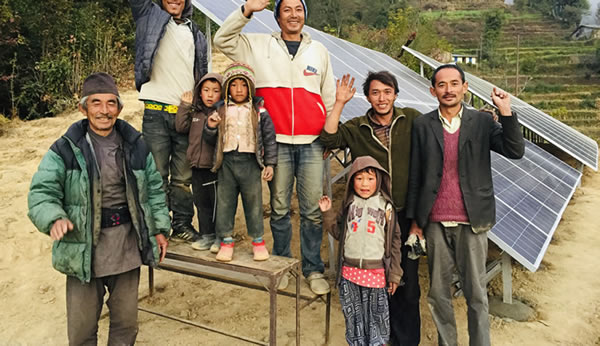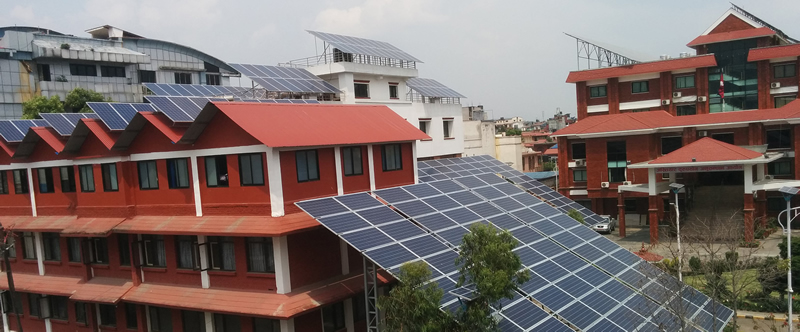Currently, only 11% of Nepal’s rural population of about 23 million people has access to electricity. It’s prohibitively expensive to string power lines across the country’s rugged, precipitously steep mountainsides. As a result, many people who live in remote villages still subsist on kerosene and batteries.

But, pioneering Nepalese renewable energy developer Gham Power has spent almost a decade tackling the electricity challenge in Nepal, and they have an impressive track record. Since its founding in 2009, the Kathmandu-based company has installed over 2,000 solar PV and hybrid renewable energy systems with a total capacity of over 2.5 MW, using HOMER software to model many of their systems. Gham Power has some important lessons to share that could benefit any organization working on energy access issues.
Gham Power has learned that in order to make community microgrids profitable and scale up their development, energy developers must find a way to finance and support successful local businesses that need electricity. When business users provide ongoing financial support for microgrids, householders with smaller power requirements can benefit from the infrastructure of a sustained electricity supply.

That finding has led Gham Power to develop new ways of planning and financing microgrids in Nepal. The company’s General Manager Anjal Niraula says “The main difficulty of implementing mini-grid projects is not technical, but defining a business model around its implementation: how to fund a project and make a viable business out of it.” Niraula elaborated on this idea for his presentation at the 2018 HOMER Energy International Microgrid conference on the vital role of “productive end use” in microgrids.
Gham Power’s Evolution in the Microgrid Market
Explaining the history of the company’s impressive growth over the past decade, Niraula says it has been driven by a shift from hydropower to solar photovoltaics that was prompted by a combination of maintenance issues, climate change, and a natural disaster. Small head hydro turbines were widely deployed in Nepal, but maintaining the turbines adequately was challenging for small, rural communities. The devastating earthquakes of 2015 destroyed many of the nation’s critical hydro systems. In addition, drought has been increasing in Nepal, and hydro doesn’t generate much electricity during drought periods. As a result, the country is moving towards solar PV as a more dependable renewable resource.

Gham Power began installing small solar systems in 2010, shortly after a massive energy crisis in Nepal. According to Niraula, there were daily power cuts in 2007 and 2008. “We were not farsighted enough to anticipate growth in energy demand,” he says. When Gham Power began servicing larger commercial customers in 2012, Niraula says he realized “The large institutions got it – hospitals, banks. They used diesel generators regularly. They made the connection and saw how much money they would save immediately with solar. They became our best customers.” That was when Gham Power began to scale and expand its business to include microgrids.
Now the company provides a variety of distributed energy developments, including water pumps for agriculture, installations for commercial and industrial customers, and micorgrids for remote communities without main grid access.
Most importantly, Gham Power has learned important lessons about how to reduce financial risk and improve the prospects for economic sustainability of its distributed energy projects.
Pathways to successful microgrids
As it grew, Gham Power found itself getting deeply involved – not only in energy – but in analyzing community income streams that could sustain hybrid renewable energy projects, and microgrids in particular. Niraula described Gham Power in his 2018 HOMER conference presentation as a “social enterprise with solar-based solutions.” He maintains that it is crucial to determine “productive end uses” for village electricity, then bundle those projects to create attractive investment opportunities. “Everybody was talking about the ABC model for microgrids (anchor, business, consumer). We got these ideas from other parts of the world, like the Philippines, and we knew ‘this is the right approach.’” But, Gham Power took the ABC model one step further, realizing that the “anchor” alone wasn’t enough. “The proportion of energy consumed by businesses overall is more important for the future of the microgrid than one anchor tenant,” says Niraula, “and we realized we need financial diversity.”

Business uses of microgrids in Nepal can include cell phone towers such as those owned by Gham Power partner NCELL (Nepal’s first private cell phone company), irrigation pumps for profitable farms, grinding mills for grain, refrigeration, and tourism. Diverse revenue streams can support a microgrid that in turn provides electricity to village households for lighting, cell phone charging, refrigeration and potentially, new businesses, and social services.”
Gham Power has also learned to include expert maintenance and streamlined payment processes. “Very early we determined that people were unable to maintain their systems adequately,” says Niraula. “We have been using lead acid batteries all along, and continue to do so because we can get them very cheaply in India. But they are not easy to maintain. Now Gham Power contracts with communities to provide operations and maintenance services for a full 10 years. Only then do we turn the microgrid over to community ownership. In the beginning though, we designed our systems to account for worst case usage. We also used to give our customers FREE maintenance for the first two years just so the systems wouldn’t fail.”
Finally, efficient payment methods are key to the financial success of community microgrids. Gham Power – the first “pay-as-you-go” renewable energy company in Nepal – uses smart meters with mobile prepayment in all of its projects, ensuring steady income and discouraging energy theft.
Looking towards the future, says Niraula, is moving beyond “one-off” projects. “We want to be able to scale up and replicate.”
Gham Power explores creative funding mechanisms
Aside from its energy expertise, Gham Power has invested considerable efforts in fundraising, identifying new sources of revenue to finance its distributed energy projects. The company wanted to figure out how to reduce risk by mixing capital from outside investors into its projects. Gham Power’s internet-savvy fundraising staff wasted no time harnessing digital strategies to attract private contributions from the international community. Their target audience is the mountain-loving tourists who have visited Nepal to trek on its trails and climb its magnificent peaks.

Fans of Nepal can give back to the country via a website called the “Off Grid Bazaar.” . The Off Grid Bazaar is an “interactive online project development platform that helps small farmers in Nepal get access to reliable and cost-effective irrigation solutions by blending debt and grants.” Making the pitch for solar pumps, Gham Power says “Studies suggest that irrigation increases the net income of small farmers by 30% to 100%. Yet, over 70% of agricultural land in Nepal is unirrigated.” With over 80 projects planned, Off-grid Bazaar has already raised $172,000 of a $209,000 goal, and makes it easy for website visitors to give donations.
While fundraising from tourists may be an unfamiliar dimension of renewable energy development, Gham Power’s solid work in microgrid finance and analysis will be relevant to energy access professionals in many parts of the world.
Learn more about Gham Power at http://ghampower.com/
Visit the Off Grid Bazaar to make a donation to an agricultural project in Nepal: https://offgridbazaar.com/

Great progress.
Keep it up.
Thanks for reading our newsletter Dudley. We would be very interested in hearing some stories from you about your work developing microgrids across Africa. Please write to us at and we can discuss some ideas.